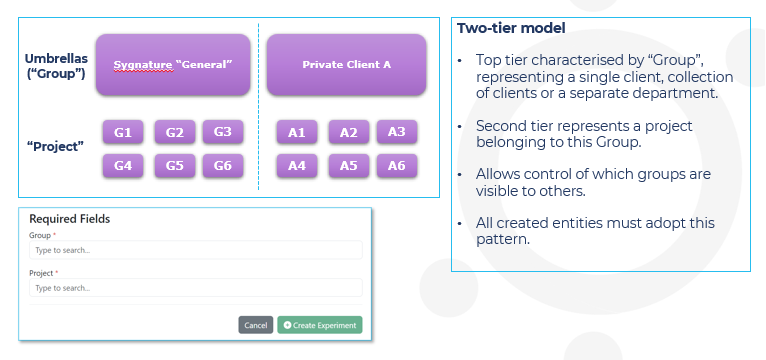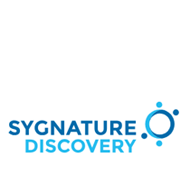Introduction
Sygnature Discovery, a global CRO, selected Signals Notebook to replace its legacy ELN, customizing the solution to streamline its specific workflows.
- Highly flexible solution enables creation of tailored workflows across departments
- Samples in Signals Notebook supports improved data consistency for compliance and patent write-ups
- Signals Notebook test environment enables incremental rollout for large organizations
Binding Global Business Units into a Single Research Operation
World-leading CRO Sygnature Discovery specializes in medicinal, synthetic, analytical, and high-throughput chemistry. The company employs a total of more than 900 scientists based in Canada and the UK, and to-date has delivered 21 candidate molecules to clinical trials.
In a highly competitive global market, the company constantly seeks ways to streamline its design and test workflows, to improve services for its clients, with the ultimate goal of improving the lives of millions of patients.
Growing through acquisition, each new Sygnature Discovery business unit ran its own operational systems, generating interoperability and efficiency challenges. In addition, the company’s legacy electronic notebook (ELN) was unable to integrate with the latest version of ChemDraw, the industry-standard communications solution. The combination of the two challenges led to significant time spent on manual data transfer and resolving collaboration issues, which distracted scientists from research, reducing throughput and productivity.
Sygnature Discovery looked for a way to bind its global business units together as a single operation, enabling rapid, secure, easy collaboration worldwide. The company aimed to reduce administration, accelerate processes, and direct scientists towards their most-productive, innovative work
Managing a Successful Transition
Among the key criteria for the new solution were integration with ChemDraw™, full interoperability with the wider research ecosystem, and the ability to capture legacy data from the company’s existing platforms. After a thorough review of the market, Sygnature Discovery selected Revvity Signals Notebook, offering flexibility for innovation while being backwards-compatible to ensure robust legacy data integrity.
Starting with a pilot implementation incorporating just two projects, the company chose to migrate incrementally using the Revvity Signals Notebook test environment and received user feedback every month. During several months of user feedback, Sygnature Discovery refined the configuration of Signals Notebook to fit its specific business needs as a CRO. For example, the company introduced layered access controls based on a two-tier organization model, helping to preserve security and protect intellectual property even for a highly distributed global workforce.
Quote from Matthew Crittall
“There are the umbrella groups, which hold all projects for individual clients, and then the project groups underneath, which hold experiments, with strict access control between the tiers. Usually, a chemist will only have access to one project at a time, preventing any possible confusion between experiments and the creation of duplicate projects.”
In parallel, Sygnature Discovery used the transition to Signals Notebook to simplify processes as much as possible to allow the chemists to focus on research instead of navigating a complex ELN. The flexible nature of the experiment templates in Signals Notebook supports the creation of a pared-back design that contains only the essentials: a reaction canvas, a write-up area, and compliance records. For example, this might include documentation for the UK’s safety-critical Control of Substances Hazardous to Health (COSHH) regulations, with a record of policies and procedures. At the same time, project managers can create and customize new templates, building agile workflows appropriate for new research and innovation.

Streamlining Compliance and Data Consistency
Moving to Signals Notebook as the company-wide ELN has transformed the company’s research operations, collaboration, and productivity in almost every area. For example, in the past the experiment context descriptors and analytical data were often stored in separate systems or as cramped comments. Now, the metadata is attached directly to the experiment within Signals Notebook, ensuring consistency and availability for future analysis.
To maximize efficiency, Sygnature Discovery insists all its scientists use the samples component in Signals Notebook, ensuring that for every isolated material at least one sample is created per successful experiment. In addition, the company instituted strict naming conventions for samples, as Matthew Crittal explains: “You sometimes get scientists making up random names for products. With Signals Notebook, we’ve been able to enact a culture change and discourage custom IDs, which has significantly improved data consistency across the board.”
Standardizing sample data improves the company’s ability to automate reaction scheme extractions for data delivery to clients. Paired with the attached metadata, the samples also create reliable one-to-one mapping between analytical data and ELN chemical structures, simplifying the reporting process for compliance and patent write-ups.
Customizing with APIs
As a large international organization, Sygnature Discovery relies not only on industry standard software such as ChemDraw, but also on specialized platforms, and it was important for the new ELN solution to integrate smoothly across the ecosystem.
For example, the company relies on its own SygScope platform to draw data from the three main scientific databases that Sygnature Discovery uses in order to simplify provision of proofs of execution for clients, and for calculations of the Design, Make, Test, Analyze cycle. Signals Notebook offers APIs that integrate experiment data into SygScope, enabling raw data exports and a search engine for experiments related to a particular target or compound. Utilizing the search engine to interrogate Signals Notebook data, Sygnature Discovery can also easily calculate the longest linear sequence for a reaction scheme, to develop products with higher yield.
Serving Chemists, Formulations and More
As Sygnature Discovery deployed Signals Notebook to its Chemistry Department, the company saw the opportunity to extend the platform to the Form and Formulation Department. By standardizing across departments, the company is able to reduce its systems management overhead, enabling greater cost-efficiency and releasing more funds for research. Based on user access and security controls, the company ensures appropriate separation of departmental data, and customizes Signals Notebook for each unit even as it preserves data quality. For example, while the Chemistry Department follows strict rules and simplified workflows, the Form and Formulations Department has access to open, flexible experiment templates with a heavier use of text and images for observations.
Positioning for Continued innovation
With Signals Notebook enabled throughout the company, Sygnature Discovery benefits from streamlined workflows tailored to each department, elevating productivity and helping to drive the innovation crucial for early drug discovery.
In addition, by using the tools in Signals Notebook to enact stricter rules around project access, product naming, and data integration, Sygnature Discovery has improved its data consistency, helping to streamline compliance and drive global scalability.
Based on very positive feedback, Sygnature Discovery plans to extend Signals Notebook across other departments and design new workflows.
Conclusion
Matthew Crittall concludes, “The Signals Notebook solution is highly adaptable and has met every unique challenge that Sygnature Discovery presents as a CRO. We are always looking forward to new features from Revvity Signals to support Sygnature Discovery, helping us on our mission to accelerate the discovery of new medicines from the lab into development, improving the lives of patients worldwide.”

End-to-end workflow support across scientific disciplines.

The Standard for Chemical Drawing.

End-to-end Clinical Data Science Platform.
